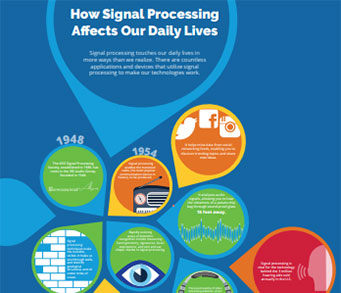SPS Feed
Top Reasons to Join SPS Today!
1. IEEE Signal Processing Magazine
2. Signal Processing Digital Library*
3. Inside Signal Processing Newsletter
4. SPS Resource Center
5. Career advancement & recognition
6. Discounts on conferences and publications
7. Professional networking
8. Communities for students, young professionals, and women
9. Volunteer opportunities
10. Coming soon! PDH/CEU credits
Click here to learn more.
The Latest News, Articles, and Events in Signal Processing
Watermarking plays an important role in identifying the copyright of an image and related issues. The state-of-the-art watermark embedding schemes, spread spectrum and quantization, suffer from host signal interference (HSI) and scaling attacks, respectively. Both of them use a fixed embedding parameter, which is difficult to take both robustness and imperceptibility into account for all images.
Screen content coding (SCC) is the extension to high-efficiency video coding (HEVC) for compressing screen content videos. New coding tools, intrablock copy (IBC), and palette (PLT) modes, are introduced to encode screen content (SC) such as texts and graphics. The IBC mode is used for encoding repeating patterns by performing block matching within the same frame, while the PLT mode is designed for SC with few distinct colors by coding the major colors and their corresponding locations using an index map.
Lecture Date: December 2, 2019
Chapter: Italy
Chapter Chair: Mauro Barni
Topic: Speech Recognition: What’s Next?
The multiple signal classification (MUSIC) algorithmis computationally expensive in the application to joint two-dimensional (2-D) direction-of-arrival (DOA) and time-of-arrival (TOA) estimation based on uniform circular array (UCA) using orthogonal frequency-division multiplexing (OFDM) signal. This letter proposed an efficient way to compute the 3-D spatial-temporal spectrum.
Two-directional two-dimensional canonical correlation analysis ((2D)
Many well-known line spectral estimators may experience significant performance loss with noisy measurements. To address the problem, we propose a deep learning denoising based approach for line spectral estimation. The proposed approach utilizes a residual learning assisted denoising convolutional neural network (DnCNN) trained to recover the unstructured noise component, which is used to denoise the original measurements.
To promote the applications of semantic segmentation, quality evaluation is important to assess different algorithms and guide their development and optimization. In this paper, we establish a subjective semantic segmentation quality assessment database based on the stimulus-comparison method. Given that the database reflects the relative quality of semantic segmentation result pairs...
In this paper, we present a novel Bayesian classification framework of the matrix variate Bingham distributions with the inclusion of its normalizing constant and develop a consistent general parametric modeling framework based on the Grassmann manifolds. To calculate the normalizing constants of the Bingham model, this paper extends the method of saddle-point approximation (SPA) to a new setting.
In a typical communication pipeline, images undergo a series of processing steps that can cause visual distortions before being viewed. Given a high quality reference image, a reference (R) image quality assessment (IQA) algorithm can be applied after compression or transmission. However, the assumption of a high quality reference image is often not fulfilled in practice, thus contributing to less accurate quality predictions when using stand-alone R IQA models.
The acoustic-to-word model based on the Connectionist Temporal Classification (CTC) criterion is a natural end-to-end (E2E) system directly targeting word as output unit. Two issues exist in the system: first, the current output of the CTC model relies on the current input and does not account for context weighted inputs. This is the hard alignment issue.
Sequence generation tasks, such as neural machine translation (NMT) and abstractive summarization, usually suffer from exposure bias as well as the error propagation problem due to the autoregressive training and generation. Many previous works have discussed the relationship between error propagation and the accuracy drop problem (i.e., the right part of the generated sentence is often worse than its left part in left-to-right decoding models).
A sound field reproduction method based on the spherical wavefunction expansion of sound fields is proposed, which can be flexibly applied to various array geometries and directivities. First, we formulate sound field synthesis as a minimization problem of some norm on the difference between the desired and synthesized sound fields, and then the optimal driving signals are derived by using the spherical wavefunction expansion of the sound fields.
Pages
SPS Social Media
- IEEE SPS Facebook Page https://www.facebook.com/ieeeSPS
- IEEE SPS X Page https://x.com/IEEEsps
- IEEE SPS Instagram Page https://www.instagram.com/ieeesps/?hl=en
- IEEE SPS LinkedIn Page https://www.linkedin.com/company/ieeesps/
- IEEE SPS YouTube Channel https://www.youtube.com/ieeeSPS














